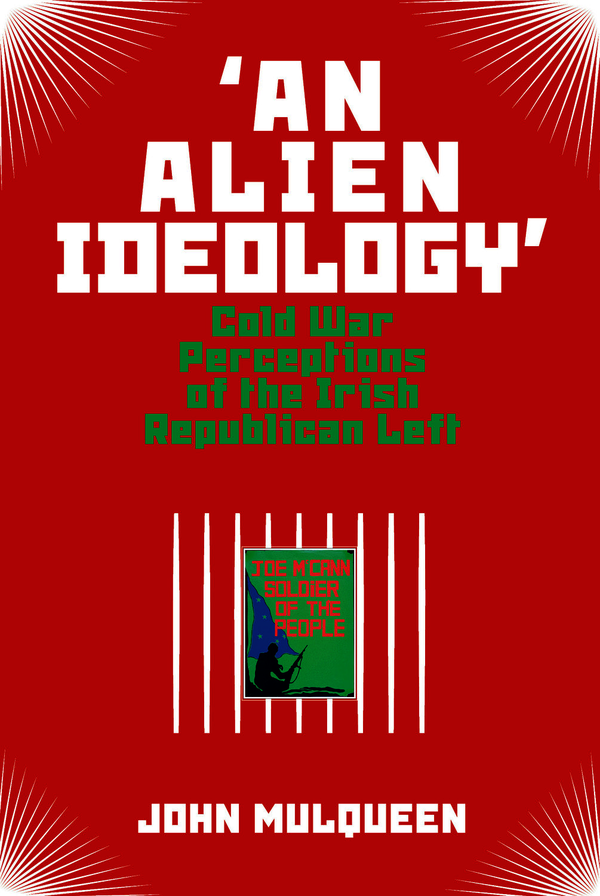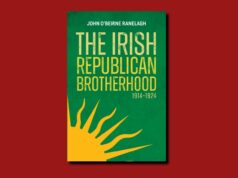
Investigating the impact of Communism in Ireland—a direct and worthwhile piece of historical research.
—John Kirkaldy on ‘An Alien Ideology’: Cold War Perceptions of the Irish Republican Left (Liverpool University Press).
by John Kirkaldy
Ireland and Communism seem a very unlikely combination. Marxism sees religion as ‘the opium of the people’ and traditional conservative Irish society – North and South – does largely regard Communism as ‘an alien ideology’.
John Mulqueen’s study investigates the impact of Communism in Ireland and concludes that it has been of importance—and not just on the republican left.
The book shows how officialdom in Ireland, Britain and America often agreed on a policy towards Communism and the IRA, and how much information and views were exchanged, usually informally.
Communism did, however, later have a direct influence on Irish politics, especially through the Official IRA and later the Workers’ Party.
It is very apparent that the book has emerged out of a PhD. Each chapter is introduced by a statement of intent and concludes with a formal summary. A 16-page introduction has no less than 64 footnotes. PhDs are not renowned for literary flourishes but the writing is direct and without frills. It is a very worthwhile bit of historical research, which adds significantly to Irish history.
Technically neutral
Although the Republic was technically neutral, there was very little doubt as to where its sympathies lay in the Cold War at the end of World War Two.
Mulqueen concludes: ‘While turning down an invitation to join NATO in 1949 saw a continuation of the Irish state’s military neutrality, there was no political neutrality.
Dublin cooperated with the British and the Americans, in combating communists and their left-wing allies.’
The Head of Ireland’s Security Service, G2, Dan Bryan, argued in 1947: ‘In Ireland at present there are at least 1,000 people who are so indoctrinated with and sympathetic to Communist ideas that on international affairs they automatically take a Russian not an Irish view.’ The term ‘Fifth Column’ was repeatedly used.
Complexity
The persecution of the Catholic Church in Eastern Europe increased these feelings. Up to 150,000 attended a demonstration on 1st May 1949 to protest against the imprisonment of Cardinal József Mindszenty, with thousands kneeling in the streets to say the rosary.
An IRA campaign in the period 1956-62 received little support in both the North and South.
The outbreak of the Troubles in the North in 1968 added a new dimension to Irish politics. The book guides the reader efficiently through the labyrinth and complexity of events of this time.
Is there any other place that has produced in the last few decades more acronyms than Ireland? The book also makes extensive use of diplomatic briefings from British and American sources. (How much more was done on the phone and in person or on records that have been ‘lost’?)
Twists and turns
As is well known, a campaign for civil rights soon escalated into more fundamental identity issues.
Crucially, there was the split in December 1969 in the IRA between the more traditional Provisionals and the Marxist inclining Officials.
Veteran Jimmy Steele complained that ‘one is now expected to be more conversant with the thoughts of Chairman Mao than those of our dead patriots.’
Seán Mac Stiofáin, the Chief of the Provisionals, explained the difference in tactics: ‘The Officials say unless you have mass involvement of the people you haven’t got a revolution. We say, the armed struggle comes first and then you politicise.’ (Governments tended by this time to use imagery of Cuba and Vietnam.)
It is almost impossible to keep up with all the twists and turns of the Official IRA between 1969 and when it changed its name to Sinn Féin, the Workers’ Party in 1977, and subsequently to the Workers’ Party in 1982.
Mulqueen proves to be a secure guide and the focus is usefully taken away from the Provisionals, which tends to dominate in most accounts of this period.
Only some of the major issues and events include: intermittent battles with the Army, RUC and the Provisionals; assassinations (such as the killing of Senator John Barnhill); criminal fund raising; bombings (the most spectacular was the attack on the Parachute Regiment’s Officers’ Mess at Aldershot in February 1972); ceasefires (temporary and semi-permanent); complex internal feuding; arms decommissioning; and the controversies surrounding the H Block and the Hunger Strikes.
Links with Russia
All the Governments concerned became increasingly anxious about the growing links between the Officials and its successors with Russia.
It was accused of supplying arms, spying and supporting the Workers’ Party with funding. In September 1983, the Republic took the unprecedented step in expelling three Russian Embassy staff.
The decision by the Workers’ Party to adopt more conventional politics seems to have paid off but only to a limited extent.
Its highpoint in gaining elected TDs to the Dáil came in 1989 with seven seats. In March 1982, its three TDs enabled Charles Haughey to form a government. It gained over the years a few local councillors with its biggest support centred on Waterford. In Northern Ireland, its biggest success came in 1973 with ten elected local councillors.
Recent past
Mulqueen’s book ends in the recent past. It is a final irony that in the Dáil elections of February 2020, Sinn Féin, the descendants in part from the Provisionals, gained 37 seats, coming only one short of being the largest party.
This book was first published in hardback nearly three years ago and its reappearance in paperback format is very much to be welcomed.

John Kirkaldy has a PhD in Irish History, worked for many years with the Open University and has been reviewing for Books Ireland since 1980. He has contributed to three Irish history anthologies, a school textbook, and has been involved in a number of Open University History documentary series. Aged 70, two years ago, he went round the world on a much delayed gap year described in his book, I’ve Got a Metal Knee: a 70-Year Old’s Gap Year.












